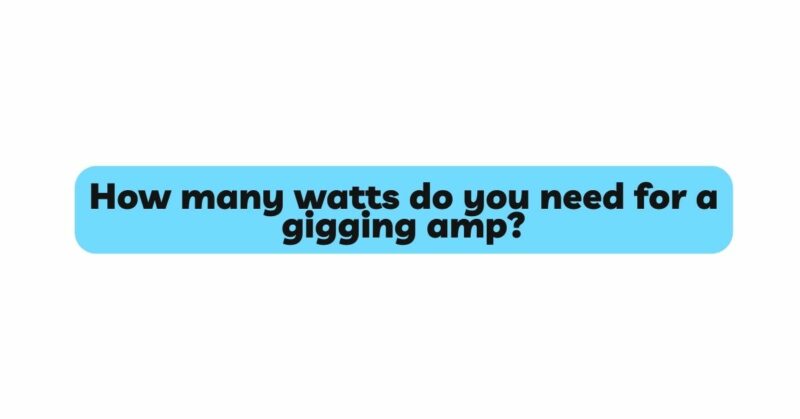The stage is set, the audience is waiting, and your musical prowess is ready to be unleashed. But before you embark on your live performance journey, a crucial decision awaits: selecting the right wattage for your gigging amplifier. The wattage of your amp plays a pivotal role in delivering your sound to the audience, striking a balance between projection, tone, and practicality. This article dives into the considerations and factors that go into determining the optimal wattage for a gigging amp, ensuring that your performances are electrifying, dynamic, and perfectly amplified.
Understanding Amplifier Wattage: Amplifier wattage refers to the power output the amplifier can deliver to drive the speakers. In a gigging context, where you’re performing in venues ranging from intimate clubs to larger stages, selecting the appropriate wattage becomes crucial to ensure your sound is heard clearly and distinctly.
Venue Size and Type: The size and type of venues you’ll be performing in significantly influence your amp’s required wattage. Smaller venues with limited stage space demand lower wattages, while larger halls and outdoor spaces necessitate higher wattages for adequate sound coverage. Consider the average capacity and layout of the venues you’ll be playing to gauge the wattage needed.
Loudness and Headroom: One of the primary reasons for choosing higher wattage is to ensure sufficient headroom. Headroom refers to the ability of the amplifier to handle dynamic peaks in your playing without distorting or clipping. Higher wattage amplifiers offer more headroom, allowing your sound to remain clean and clear even during intense playing moments.
Genre and Playing Style: The genre of music you play and your playing style also impact your amp’s wattage requirements. If you’re in a heavy metal band where distortion and high gain are integral to your sound, you might need higher wattage to maintain clarity and punch. Conversely, genres like jazz or acoustic performances may demand lower wattage for more nuanced, controlled sound.
Bass and Low-End Presence: If your music relies heavily on bass frequencies, you’ll need an amp with enough wattage to reproduce those frequencies accurately. Bass frequencies require more power to project clearly, so consider the emphasis your music places on the low end when selecting amp wattage.
Stage Volume vs. Front-of-House Sound: It’s important to distinguish between stage volume and the sound projected to the audience through the venue’s front-of-house (FOH) system. While you might be tempted to crank up your amp for maximum stage volume, the FOH system is responsible for delivering your sound to the audience. Higher wattage can lead to better projection on stage, but it’s the FOH system’s job to ensure the audience hears a balanced mix.
Amplifier Efficiency and Speaker Sensitivity: Amplifier efficiency and speaker sensitivity play a role in determining the effective output of your amp. An efficient amplifier coupled with sensitive speakers can deliver more sound per watt. Conversely, less efficient amplifiers might require higher wattages to achieve the same volume level.
Consider the Band Setup: The size and instrumentation of your band can impact your amp’s wattage needs. If you’re part of a larger band with multiple instruments, including drums, keyboards, and brass, you might need more wattage to cut through the mix. In contrast, smaller setups might require lower wattages for a balanced sound.
Practicality and Portability: While higher wattage might be tempting for larger venues, practicality and portability should also factor into your decision. Carrying a massive, high-wattage amp to every gig can be cumbersome, especially if you’re playing smaller venues where such power isn’t necessary. Consider striking a balance between wattage and portability.
Amplifier Classes and Tone: Different amplifier classes, such as Class A, Class AB, and Class D, offer distinct tonal characteristics. Class A amplifiers, known for their warm and organic sound, are often lower wattage and suitable for smaller gigs. Class AB and Class D amplifiers provide a range of tonal options with varying wattages, catering to different genres and playing styles.
Feedback and Sound Control: Higher wattage amplifiers can be more prone to feedback, especially in smaller venues with reflective surfaces. It’s essential to have control over your sound and feedback prevention measures to ensure a seamless performance.
Versatility and Future-Proofing: Opting for an amp with slightly higher wattage than you currently need can provide versatility for future performances. It gives you room to grow and adapt to different gigging scenarios without immediately needing to upgrade your equipment.
Conclusion: Choosing the right wattage for a gigging amplifier requires a thoughtful consideration of various factors, including venue size, playing style, genre, speaker sensitivity, and practicality. Striking a balance between power, portability, and tonal requirements ensures that your performances are dynamically expressive, impactful, and well-projected to the audience. Whether you opt for a lower wattage amp for intimate settings or a higher wattage beast for massive stages, the goal is to amplify your musical expression in a way that resonates with both you and your audience.

